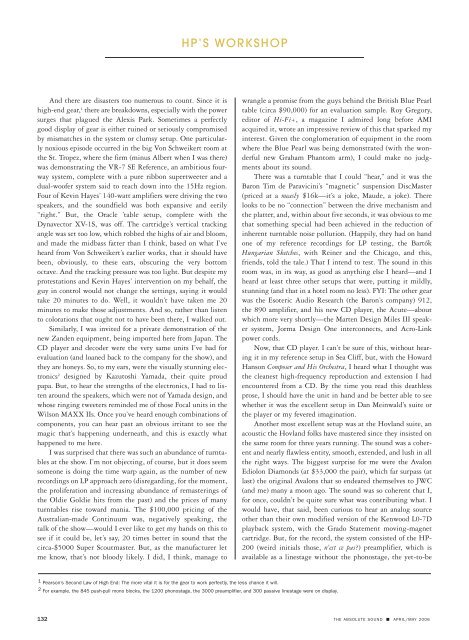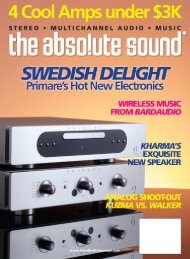in this issue
in this issue
in this issue
You also want an ePaper? Increase the reach of your titles
YUMPU automatically turns print PDFs into web optimized ePapers that Google loves.
HP’S WORKSHOP<br />
And there are disasters too numerous to count. S<strong>in</strong>ce it is<br />
high-end gear, 1 there are breakdowns, especially with the power<br />
surges that plagued the Alexis Park. Sometimes a perfectly<br />
good display of gear is either ru<strong>in</strong>ed or seriously compromised<br />
by mismatches <strong>in</strong> the system or clumsy setup. One particularly<br />
noxious episode occurred <strong>in</strong> the big Von Schweikert room at<br />
the St. Tropez, where the firm (m<strong>in</strong>us Albert when I was there)<br />
was demonstrat<strong>in</strong>g the VR-7 SE Reference, an ambitious fourway<br />
system, complete with a pure ribbon supertweeter and a<br />
dual-woofer system said to reach down <strong>in</strong>to the 15Hz region.<br />
Four of Kev<strong>in</strong> Hayes’ 140-watt amplifiers were driv<strong>in</strong>g the two<br />
speakers, and the soundfield was both expansive and eerily<br />
“right.” But, the Oracle ’table setup, complete with the<br />
Dynavector XV-1S, was off. The cartridge’s vertical track<strong>in</strong>g<br />
angle was set too low, which robbed the highs of air and bloom,<br />
and made the midbass fatter than I th<strong>in</strong>k, based on what I’ve<br />
heard from Von Schweikert’s earlier works, that it should have<br />
been, obviously, to these ears, obscur<strong>in</strong>g the very bottom<br />
octave. And the track<strong>in</strong>g pressure was too light. But despite my<br />
protestations and Kev<strong>in</strong> Hayes’ <strong>in</strong>tervention on my behalf, the<br />
guy <strong>in</strong> control would not change the sett<strong>in</strong>gs, say<strong>in</strong>g it would<br />
take 20 m<strong>in</strong>utes to do. Well, it wouldn’t have taken me 20<br />
m<strong>in</strong>utes to make those adjustments. And so, rather than listen<br />
to colorations that ought not to have been there, I walked out.<br />
Similarly, I was <strong>in</strong>vited for a private demonstration of the<br />
new Zanden equipment, be<strong>in</strong>g imported here from Japan. The<br />
CD player and decoder were the very same units I’ve had for<br />
evaluation (and loaned back to the company for the show), and<br />
they are honeys. So, to my ears, were the visually stunn<strong>in</strong>g electronics<br />
2 designed by Kazutoshi Yamada, their quite proud<br />
papa. But, to hear the strengths of the electronics, I had to listen<br />
around the speakers, which were not of Yamada design, and<br />
whose r<strong>in</strong>g<strong>in</strong>g tweeters rem<strong>in</strong>ded me of those Focal units <strong>in</strong> the<br />
Wilson MAXX IIs. Once you’ve heard enough comb<strong>in</strong>ations of<br />
components, you can hear past an obvious irritant to see the<br />
magic that’s happen<strong>in</strong>g underneath, and <strong>this</strong> is exactly what<br />
happened to me here.<br />
I was surprised that there was such an abundance of turntables<br />
at the show. I’m not object<strong>in</strong>g, of course, but it does seem<br />
someone is do<strong>in</strong>g the time warp aga<strong>in</strong>, as the number of new<br />
record<strong>in</strong>gs on LP approach zero (disregard<strong>in</strong>g, for the moment,<br />
the proliferation and <strong>in</strong>creas<strong>in</strong>g abundance of remaster<strong>in</strong>gs of<br />
the Oldie Goldie hits from the past) and the prices of many<br />
turntables rise toward mania. The $100,000 pric<strong>in</strong>g of the<br />
Australian-made Cont<strong>in</strong>uum was, negatively speak<strong>in</strong>g, the<br />
talk of the show—would I ever like to get my hands on <strong>this</strong> to<br />
see if it could be, let’s say, 20 times better <strong>in</strong> sound that the<br />
circa-$5000 Super Scoutmaster. But, as the manufacturer let<br />
me know, that’s not bloody likely. I did, I th<strong>in</strong>k, manage to<br />
wrangle a promise from the guys beh<strong>in</strong>d the British Blue Pearl<br />
table (circa $90,000) for an evaluation sample. Roy Gregory,<br />
editor of Hi-Fi+, a magaz<strong>in</strong>e I admired long before AMI<br />
acquired it, wrote an impressive review of <strong>this</strong> that sparked my<br />
<strong>in</strong>terest. Given the conglomeration of equipment <strong>in</strong> the room<br />
where the Blue Pearl was be<strong>in</strong>g demonstrated (with the wonderful<br />
new Graham Phantom arm), I could make no judgments<br />
about its sound.<br />
There was a turntable that I could “hear,” and it was the<br />
Baron Tim de Paravic<strong>in</strong>i’s “magnetic” suspension DiscMaster<br />
(priced at a measly $16k—it’s a joke, Maude, a joke). There<br />
looks to be no “connection” between the drive mechanism and<br />
the platter, and, with<strong>in</strong> about five seconds, it was obvious to me<br />
that someth<strong>in</strong>g special had been achieved <strong>in</strong> the reduction of<br />
<strong>in</strong>herent turntable noise pollution. (Happily, they had on hand<br />
one of my reference record<strong>in</strong>gs for LP test<strong>in</strong>g, the Bartók<br />
Hungarian Sketches, with Re<strong>in</strong>er and the Chicago, and <strong>this</strong>,<br />
friends, told the tale.) That I <strong>in</strong>tend to test. The sound <strong>in</strong> <strong>this</strong><br />
room was, <strong>in</strong> its way, as good as anyth<strong>in</strong>g else I heard—and I<br />
heard at least three other setups that were, putt<strong>in</strong>g it mildly,<br />
stunn<strong>in</strong>g (and that <strong>in</strong> a hotel room no less). FYI: The other gear<br />
was the Esoteric Audio Research (the Baron’s company) 912,<br />
the 890 amplifier, and his new CD player, the Acute—about<br />
which more very shortly—the Marten Design Miles III speaker<br />
system, Jorma Design One <strong>in</strong>terconnects, and Acro-L<strong>in</strong>k<br />
power cords.<br />
Now, that CD player. I can’t be sure of <strong>this</strong>, without hear<strong>in</strong>g<br />
it <strong>in</strong> my reference setup <strong>in</strong> Sea Cliff, but, with the Howard<br />
Hanson Composer and His Orchestra, I heard what I thought was<br />
the cleanest high-frequency reproduction and extension I had<br />
encountered from a CD. By the time you read <strong>this</strong> deathless<br />
prose, I should have the unit <strong>in</strong> hand and be better able to see<br />
whether it was the excellent setup <strong>in</strong> Dan Me<strong>in</strong>wald’s suite or<br />
the player or my fevered imag<strong>in</strong>ation.<br />
Another most excellent setup was at the Hovland suite, an<br />
acoustic the Hovland folks have mastered s<strong>in</strong>ce they <strong>in</strong>sisted on<br />
the same room for three years runn<strong>in</strong>g. The sound was a coherent<br />
and nearly flawless entity, smooth, extended, and lush <strong>in</strong> all<br />
the right ways. The biggest surprise for me were the Avalon<br />
Ediolon Diamonds (at $33,000 the pair), which far surpass (at<br />
last) the orig<strong>in</strong>al Avalons that so endeared themselves to JWC<br />
(and me) many a moon ago. The sound was so coherent that I,<br />
for once, couldn’t be quite sure what was contribut<strong>in</strong>g what. I<br />
would have, that said, been curious to hear an analog source<br />
other than their own modified version of the Kenwood L0-7D<br />
playback system, with the Grado Statement mov<strong>in</strong>g-magnet<br />
cartridge. But, for the record, the system consisted of the HP-<br />
200 (weird <strong>in</strong>itials those, n’est ce pas?) preamplifier, which is<br />
available as a l<strong>in</strong>estage without the phonostage, the yet-to-be<br />
1 Pearson’s Second Law of High End: The more vital it is for the gear to work perfectly, the less chance it will.<br />
2 For example, the 845 push-pull mono blocks, the 1200 phonostage, the 3000 preamplifier, and 300 passive l<strong>in</strong>estage were on display.<br />
132 THE ABSOLUTE SOUND ■ APRIL/MAY 2006










